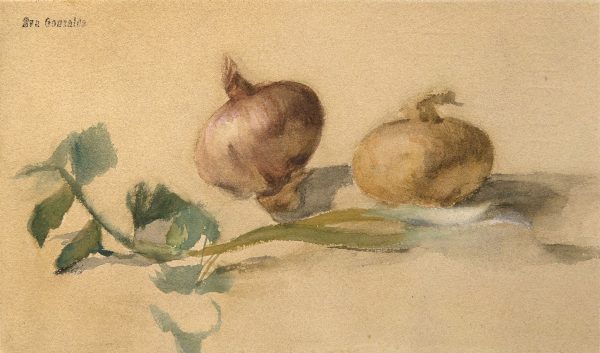Still life with two onions, Ca. 1871-1872.
Watercolour, H. 0.10 mm; W. 0.207 mm
Studio’s stamp on the top left.
Provenance: Eva Gonzalès Sale, Paris, Hôtel Drouot, 20 février 1885, no. 77
Collection of Jean-Raymond Guérard, Paris
Collection of Alfred Daber, Paris.
Marie Caroline Sainsaulieu et Jacques de Mons, Eva Gonzalès, 1849-1883, Etude critique et catalogue raisonné, Paris, 1990, p. 94, no. 28 (ill.).
Eva Gonzalès was born in Paris to a bourgeois family of Spanish origin who had settled in France. Her father was the famous writer, Emmanuel Gonzalès. In 1866, at the age of 16, Eva first went to the workshop of Charles Chaplin, a fashionable painter to whom wealthy families often sent their daughters. In 1867, however, she definitively walked out the door, considering Chaplin’s teaching to be overly classical.
Two years later, she met Manet and became his student. The close friendship and mutual admiration that bound them were deeply envied by Berthe Morisot. Manet completed a portrait of Eva in 1869 and exhibited it in the 1870 Salon, where she presented Le Clairon, directly inspired by Manet’s Fifre.
Eva Gonzalès, following in the footsteps of her teacher, worked on numerous still life paintings, as well as plein-air and Intimist scenes, using watercolours, oils and pastels. While many of the subjects of her works were the same as those chosen by the Impressionists, her style remains distinct, closer to Manet’s early Spanish paintings.
Following the Salon of 1879, where she exhibited Une loge aux Italiens, the public and art critics finally began appreciating her work and recognising her talent after many years of indifference. While she refused to participate in the Impressionist Exhibitions, she remained close to the artistic movement and its followers. In 1879, Eva Gonzalès married Henri Guérard, Manet’s engraver, who also painted occasionally. She died brutally of an embolism following the birth of their son, Jean-Raymond Guérard, in 1883. It was only six days after the death of her teacher and friend Manet, for whom she had been preparing a tribute.

